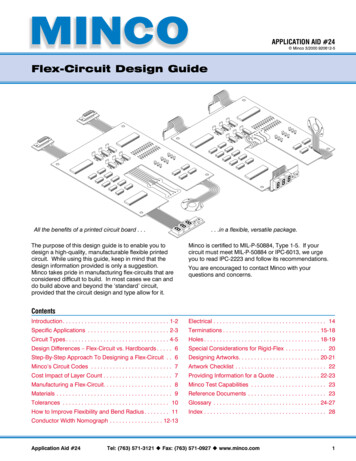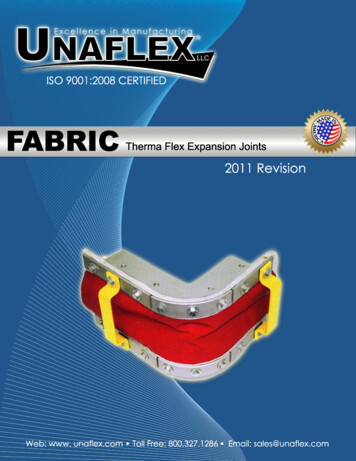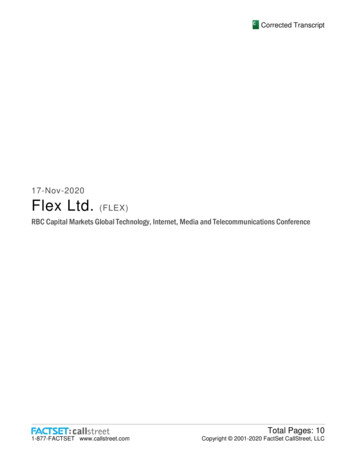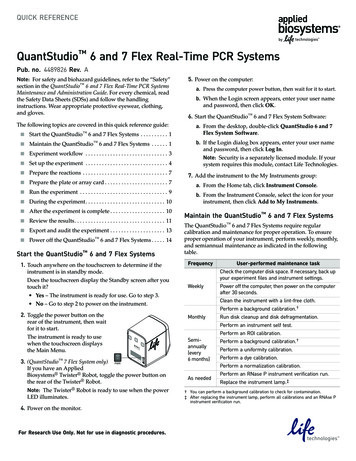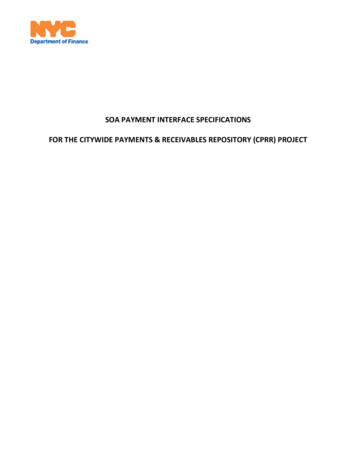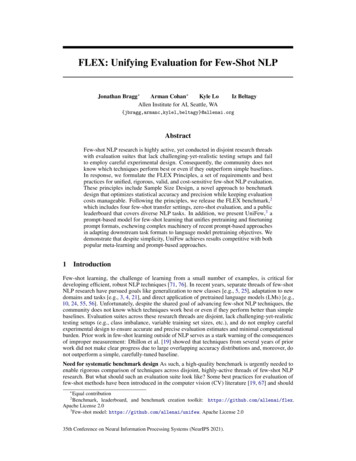
Transcription
FLEX: Unifying Evaluation for Few-Shot NLPJonathan Bragg Arman Cohan Kyle LoAllen Institute for AI, Seattle, WAIz stractFew-shot NLP research is highly active, yet conducted in disjoint research threadswith evaluation suites that lack challenging-yet-realistic testing setups and failto employ careful experimental design. Consequently, the community does notknow which techniques perform best or even if they outperform simple baselines.In response, we formulate the FLEX Principles, a set of requirements and bestpractices for unified, rigorous, valid, and cost-sensitive few-shot NLP evaluation.These principles include Sample Size Design, a novel approach to benchmarkdesign that optimizes statistical accuracy and precision while keeping evaluationcosts manageable. Following the principles, we release the FLEX benchmark,2which includes four few-shot transfer settings, zero-shot evaluation, and a publicleaderboard that covers diverse NLP tasks. In addition, we present UniFew,3 aprompt-based model for few-shot learning that unifies pretraining and finetuningprompt formats, eschewing complex machinery of recent prompt-based approachesin adapting downstream task formats to language model pretraining objectives. Wedemonstrate that despite simplicity, UniFew achieves results competitive with bothpopular meta-learning and prompt-based approaches.1 IntroductionFew-shot learning, the challenge of learning from a small number of examples, is critical fordeveloping efficient, robust NLP techniques [71, 76]. In recent years, separate threads of few-shotNLP research have pursued goals like generalization to new classes [e.g., 5, 25], adaptation to newdomains and tasks [e.g., 3, 4, 21], and direct application of pretrained language models (LMs) [e.g.,10, 24, 55, 56]. Unfortunately, despite the shared goal of advancing few-shot NLP techniques, thecommunity does not know which techniques work best or even if they perform better than simplebaselines. Evaluation suites across these research threads are disjoint, lack challenging-yet-realistictesting setups (e.g., class imbalance, variable training set sizes, etc.), and do not employ carefulexperimental design to ensure accurate and precise evaluation estimates and minimal computationalburden. Prior work in few-shot learning outside of NLP serves as a stark warning of the consequencesof improper measurement: Dhillon et al. [19] showed that techniques from several years of priorwork did not make clear progress due to large overlapping accuracy distributions and, moreover, donot outperform a simple, carefully-tuned baseline.Need for systematic benchmark design As such, a high-quality benchmark is urgently needed toenable rigorous comparison of techniques across disjoint, highly-active threads of few-shot NLPresearch. But what should such an evaluation suite look like? Some best practices for evaluation offew-shot methods have been introduced in the computer vision (CV) literature [19, 67] and should Equal contributionBenchmark, leaderboard, and benchmark creation toolkit: https://github.com/allenai/flex.Apache License 2.03Few-shot model: https://github.com/allenai/unifew. Apache License 2.0235th Conference on Neural Information Processing Systems (NeurIPS 2021).
Table 1: Comparison of the FLEX benchmark with closest prior work. Our benchmark consists ofepisodes with variable number of shots in the range [1-5] and with class imbalance. “No extra testdata” refers to excluding validation data from testing tasks, to avoid unfairly advantaging modelsthat use such data [50]. Our benchmark’s number of test episodes is selected to balance statisticalaccuracy and precision, which suffers in few-episode setups, and compute requirements, which is toocostly in many-episode setups (§5).CrossFit[75] LM-BFF[24] GPT-3[10]Class TransferDomain TransferTask TransferXPretraining TransferShots per class{16, 32}Variable shotsUnbalancedTextual labelsXZero-shotNo extra test data# test episodes5Reportingavg# datasets160X16XX5avg, SD16XvariableXXX1avg37DS[5]SMLMT[4] FewGlue[56] FLEX (ours)XXX{1,5} {4,8,16,32}XX100010avg, SD avg, SD718X{total 32}4Xmixed51avg, SD8XXXX[1–5]XXXXX90all620be applied to NLP. However, unifying few-shot NLP work introduces new challenges. For example,the benchmark needs to test all types of transfer studied in separate research threads to measureprogress on new techniques that make gains in each of these important generalization settings (§2).Also, given the importance of zero-shot learning and learning from task descriptions [29, 73], thebenchmark needs to include zero-shot episodes and textual labels to enable measuring progressfor models that do not use conventional supervised training, including methods that leverage thelatent knowledge in pretrained LMs [10, 24, 78]. Further, the benchmark must accommodate new,computationally-expensive approaches, without overly reducing the number of evaluation episodes atthe expense of statistical accuracy [3, 24, 75].Need for a robust few-shot model Recent prompt-based models [10] have shown strong results infew-shot learning. These models leverage the power of (often large) pretrained language modelsand adapt the format of downstream tasks to the underlying pretraining objective (e.g., MaskedLanguage Modeling). This way, given the right natural language prompt (and sometimes verbalizers[55] and additional demonstrative examples), the model can quickly fine-tune on the downstream task[24, 43, 44, 55, 56]. However, adapting task formats to the underlying (masked) language modelingobjectives is not straightforward; such models have been shown to be sensitive to varying choices ofthe prompt/demonstrations, training settings, hyperparameters, and learning algorithms [33, 50, 78],often requiring large held out sets and/or complex methods to overcomes such challenges. Canmodels eschew complex prompt engineering by unifying pretraining and downstream task formats?In this paper, we tackle these key issues by introducing FLEX—Few-shot Language Evaluationacross (X) many transfer types—and contributing the following: FLEX Principles (§3), a set of requirements and best practices for few-shot NLP evaluationthat enables unified, rigorous, valid, and cost-sensitive measurements.– Sample Size Design: In support of valid, cost-sensitive measurement, we introduce anovel approach to few-shot sample size design (§5) that optimizes for a benchmark’sstatistical accuracy and precision while keeping computational costs accessible to abroad range of researchers. FLEX benchmark (§4), an implementation of the FLEX Principles. It tests across fourfew-shot transfer settings,7 and includes a public leaderboard for few-shot NLP that covers20 datasets across diverse NLP tasks (e.g., NLI, relation classification, entity typing). Table 1summarizes key differences between FLEX and other few-shot NLP evaluation suites.4The total number of training shots in each episode, not number of shots per class per episode.Most users use unlabeled examples, though recently, Tam et al. [65] do not.6Average (avg), confidence interval (CI), standard deviation (SD), individual episode metrics7Prior work evaluated at most two settings.52
UniFew (§6), a prompt-based model for few-shot learning in NLP. While most existingmethods leverage pre-trained LMs for few-shot learning, LM pre-training tasks do notclosely match natural downstream task formats, requiring complex methods (e.g., extensiveprompt-engineering, use of verbalizers, episodic hyperparameter tuning, custom learningalgorithms) to make these models work in few-shot setting. Instead, the key idea of ourmodel, UniFew, is to close the gap between pre-training and fine-tuning formats by posingtasks as multiple-choice QA and using an underlying model that is pre-trained on a similarnatural QA task format. This eliminates the need for complexities of adapting downstreamtasks to the LM objectives, while resulting in competitive performance with both recentfew-shot and meta-learning methods.To aid similar efforts, our release of FLEX includes a toolkit for benchmark creation and few-shotNLP model development, which we used to create the FLEX benchmark and train UniFew.2 Background and Related WorkWe first provide background and notation for few-shot learning and evaluation, then discuss relatedwork in NLP and outside NLP that motivated us to create the FLEX Principles and benchmark.Few-shot background and notation Broadly, modern approaches to few-shot learning are evaluated in a three-phase procedure [68]. In the first phase, a general-purpose pretrained model is obtained.In the subsequent “meta-training” phase,8 techniques aim to adapt the model to be well-suited forfew-shot generalization. Finally, a “meta-testing” phase evaluates the adapted model in new few-shotprediction settings.Let D be a dataset of (x, y) examples with full label set YD . From it, we construct three sets ofepisodes, corresponding to meta-training, meta-validation, and meta-testing and denoted by Etrain ,Eval , and Etest , respectively. Each episode in each of these sets is a few-shot problem with its own testEEEEEset and other attributes. Formally, each episode E is a tuple (Dtrain, Dval, Dtest, YD), where YDis aEsampled subset of labels in YD and Dtrain val test are disjoint sets of examples from D with labels inE 9EYD. For each episode, the model’s objective is to correctly predict labels for examples Dtest. ToEaccomplish this, models make use of labeled examples in Dtrain , which is typically configured suchEthat each label i in YDhas KiE provided examples; KiE is known as the shot, and the setting when aEclass has no examples in Dtrain(i.e., KiE 0) is called zero-shot.Few-shot evaluation in NLP Research in few-shot NLP has proceeded in several parallel threads,each focused on a different type of transfer ability [76]. Each thread has separate evaluation practices,and the vast majority of few-shot NLP research has limited evaluation to a single transfer type (seeTable 1). Here, we describe these types of transfer and their evaluation practices.Following the CV literature [67, 68], one thread of few-shot NLP focuses on class transfer, theproblem of generalizing from a supervised set of classes at meta-train time to a different set of classesDfrom the same dataset at meta-test time. Evaluation typically involves splitting classes YD into Ytrain,DDYval and Ytest disjoint subsets. Class transfer has been studied on many text classification tasks [5],including relation classification [25, 28, 64], intent classification [37, 64], inter alia. In contrast,domain transfer keeps the same classes between meta-training and meta-testing but changes thetextual domain (e.g., generalizing from MNLI to science-focused SciTail [4, 21]). Evaluation thenrequires identifying pairs of datasets with the same classes YD , where one dataset’s episodes areassigned to Etrain and the other’s to Etest . Domain transfer has also been studied on many tasks [3, 4],including dialogue intent detection & slot tagging [31], sentiment classification [77], NLI [21], andmachine translation [27, 58].Researchers have also begun to study task transfer, the problem of generalizing from a set oftasks at meta-train time to unseen tasks at meta-test time. Evaluation requires tasks (e.g., NLI)appearing in Etest not to appear in Etrain or Eval . Prior work has used GLUE tasks [70] for meta-trainingbefore meta-testing on tasks such as entity typing [3, 4], while other work instead used GLUE for89Meta-training may include a “meta-validation" component, for validating generalization.EEEIn the few-shot literature, Dtrainand Dtestare also called the support and query sets, and YD the way.3
meta-testing [21]. Very recent work has studied task transfer over a large set of datasets [75, 80]. Alimited amount of work evaluates both domain and task transfer [3, 4, 21]. An important emergingline of work (not noted by Yin [76]) is pretraining transfer, the problem of whether pretrainedlanguage models can perform well at meta-test time without any meta-training. Evaluation in thissetting requires Etrain , Eval . Prior work has shown that pretrained language models are capable ofsurprising performance on many few-shot tasks, even without fine-tuning [10]. More recent work,mainly focusing on text classification, has reported further gains with cloze-style formats [55, 56, 65],prompt engineering [24], or calibration [78]. FLEX is designed to exercise all four of these transfertypes from previous work.Few-shot evaluation outside NLP The few-shot learning literature has largely focused on imageclassification, with the introduction of increasingly complex meta-learning algorithms [e.g., 23, 39,54, 61, 68]. However, more recent work has shown that simple fine-tuning baselines are in factcompetitive, and attribute this delayed discovery to problematic evaluation methodology [15, 19].FLEX adopts recommended methodology [19, 67], and we introduce an analogous baseline (UniFew)to provide a strong measurement foundation for few-shot NLP.3 FLEX Principles for Few-Shot NLP EvaluationWe now enumerate key desiderata for a few-shot NLP benchmark capable of solving the urgentproblems with few-shot NLP evaluation, including separate evaluations for each transfer type andfailure to incorporate best measurement practices from other domains (§2).Diversity of transfer types To make NLP models broadly useful, few-shot NLP techniques must becapable of class, domain, and task transfer. Moreover, techniques should make use of the relevantsupervision provided during meta-training to increase performance compared to the pretrainingtransfer setting. The benchmark should measure all four transfer settings to ensure that the communitydevelops techniques that improve on strong pretraining transfer baselines, and enable comparisonacross these currently separate threads of research.Variable number of shots and classes To better simulate a variety of real-world scenarios, thebenchmark should include a variety of training set sizes and numbers of classes [67]. Testingrobustness to these factors is crucial; few-shot techniques are often sensitive to changes in thesefactors [12], yet all prior few-shot NLP evaluations we are aware of used a fixed number of trainingshots and classes, known in advance during meta-training.Unbalanced training sets The benchmark should also include unbalanced training sets with differenttraining shots per class, another realistic setting adopted by CV benchmarks [67]. Class imbalancehas also been observed to degrade performance [11, 47], yet prior few-shot NLP evaluations do notinclude this setting either.Textual labels While numerical label values are often used in classification tasks, descriptive textuallabels are also present for many tasks. Making these textual labels available for use by few-shottechniques enables the development of techniques that can leverage the class name, like in-contextlearning [10], template generation [24], and meta-learning [45]. Textual labels are crucial in particularfor zero-shot evaluation.Zero-shot evaluation We believe zero-shot evaluation is integral to the goals of few-shot evaluation.Similar to the motivation for measuring pretraining transfer, zero-shot evaluation is an important usecase and also provides a strong baseline for some tasks. In the absence of training examples, textualclass labels or richer task descriptions [73] must be provided. Some recent few-shot NLP work [e.g.,10, 24] evaluated with zero training shots, but most [e.g., 3, 5, 75] did not.E No extra meta-testing data We believe the benchmark should not provide validation data (Dval , E Etest ) or unlabeled data for meta-testing tasks, since few-shot learning seeks to enablehigh performance in environments where collecting additional data is costly.10 Variation in thesedimensions in prior NLP work makes comparison of results extremely difficult because it is oftenunder-reported and gives unfair advantage to approaches that leverage such data [50]. For example, per-episode hyperparameter tuning on extra data has been shown to greatly inflate evaluationscores [24]. A few researchers [5, 65] follow our suggested approach, but others have used many10Unlabeled data collection can be costly too, e.g. due to manual filtering [16].4
different settings, from validation sets of various sizes [10, 24, 79] to no validation set but a large setof unlabeled examples [55, 56].Principled sample size design Promising few-shot techniques can incur significant computationalcost per episode, e.g., due to fine-tuning model parameters [4], searching for prompts [24], interalia. To alleviate these costs, related works often evaluate with a limited number of episodes, whichprecludes statistically accurate or precise performance estimates. We believe the benchmark’s testsample size should be optimized to enable proper performance evaluation for such techniques, whileensuring the computational burden is inclusive toward researchers without large compute resources.Proper reporting of CIs, SDs, and individual results The benchmark should report confidenceintervals (CIs) of performance estimates and follow recent guidelines [19] to report standard deviations(SDs) for understanding variability. Moreover, we newly advocate for controlling for the samesampled few-shot episodes across all methods and reporting individual episode results, so thatresearchers can run higher-powered paired statistical tests when comparing results [22], crucial whenthe benchmark has been optimized for low evaluation budgets.4 FLEX BenchmarkThe FLEX benchmark is a unifying, rigorous evaluation suite for few-shot learning in NLP, whichimplements the desiderata outlined in the previous section. In this section, we describe detailed designdecisions and our accompanying few-shot NLP toolkit (§4.4), which we are releasing to facilitateeasily adding NLP datasets and advanced sampling options to future benchmarks. We also describethe FLEX leaderboard (§4.5).4.1Task and Dataset SelectionFollowing GLUE [70] and other prior work [3, 5, 24, 78], we focus on tasks formatted as classification. Despite recent advances, NLP state-of-the-art models remain significantly worse than humanperformance on many text classification tasks, particularly in the few-shot setting. Automatic scoringof classification tasks is also more reliable than text generation tasks.We selected datasets across three recent few-shot NLP evaluation suites, which separately studiedclass transfer [5], domain and task transfer [3, 4], and pretraining transfer [24]. Our benchmarkincludes a broad mix of tasks (NLI, question classification, entity typing, relation classification, andsentiment analysis) and formats (document, sentence, sentence pair). More complete dataset andlicense details are available in the following subsection and Appendix A.4.2Meta-Evaluation ProtocolsAs discussed earlier, FLEX evaluates four different types of transfer: Class, Domain, Task, andPretraining Transfer. To support all types, we report results to the FLEX benchmark both without metatraining (pretraining-only) and with meta-training. This reporting scheme evaluates the performanceof the basic pretrained model and the benefit (or lack thereof) of meta-training. A similar reportingscheme was proposed by Triantafillou et al. [67] for CV.Pretraining-Only In this setting, the pretrained model is directly meta-tested on our benchmarkwithout any additional training. This is the Pretraining Transfer setting, and it is the most difficult,but given the recent success of pretrained models in NLP for few-shot learning [10, 24], we believethat comparison to models without any meta-training is important for NLP tasks.Meta-Trained In this setting, the model is meta-trained then meta-tested on our benchmark. Wecarefully selected and split datasets across meta-train/validation/test in order to enable testing ofClass, Domain, and Task transfer with a single meta-training phase (to reduce computational burden).Datasets involved in each transfer setting (detailed split information in Table 4 in Appendix A): Class Transfer: FewRel [28], HuffPost [46], Amazon [30], 20News [38], and Reuters [41]take part in meta-training and meta-testing but with different classes. Domain Transfer: MR [49], CR [32], SNLI [9], and SciTail [35] are only in the meta-testingphase, but the corresponding sentiment and NLI datasets exist in the meta-training phase(MNLI [74], QNLI [52], and SST-2 [62]).5
Task Transfer: Subj [48], TREC [69], and CoNLL [66] are also for meta-testing only, andthey represent tasks that the model does not encounter during meta-training.Instead of per-episode hyperparameter tuning, we provide meta-validation episodes Eval for learning(during meta-training) global hyperparameters that work across all episodes. Specifically, the metavalidation dataset splits (see Table 4) consist of CoLa [72] for task transfer, WNLI [40] for domaintransfer, and the validation splits used by Bao et al. [5] for all class transfer datasets. Following [3],we also include meta-training datasets MRPC [20], RTE [6, 8, 17, 26], and QQP [70].4.3Episode SamplingWe describe how our benchmark samples meta-testing episodes Etest . For meta-training, we allowusers to sample from Etrain , Eval in any way, or directly use the underlying dataset splits.Number of classes For Class Transfer datasets, FLEX evaluates model robustness to variable numberof new classes. When constructing episode E from one of these datasets D, our benchmark samplesan episode-specific number of classes from dataset D, the sampler picks a random number from theErange YD Unif(5, min( YD , 10)).11 For Domain and Task Transfer, the number of classes is fixedto the maximum number of classes in each dataset because Class Transfer is not being evaluated.Number of shots Following prior work outside NLP [47, 67], our benchmark samples the trainingshot independently for each episode E and class i, as KiE Unif(Kmin , Kmax ), where Kmin 1.Given strong performance of NLP models with few or even zero examples [10, 73] and followingprior work [5], we set the limit Kmax 5. Separately, we allocate an equal number of episodes asEzero-shot, where we instead set Dtrain (equivalently, KiE 0, i). In each episode, examples aresampled uniformly at random without replacement (but can be reused across episodes).12 FollowingTriantafillou et al. [67], we select a testing shot that is balanced across classes and leaves roughlyhalf of examples for sampling the training examples. The total number of episodes for each reportedconfiguration (pair of dataset and either zero- or few-shot) is set to 90 using Sample Size Design (§5).4.4Extensible Toolkit for Benchmark Creation and Model Training & EvaluationAlongside the FLEX benchmark, we release an extensible, highly-configurable Python toolkit, whichwe used to generate the benchmark, and train and evaluate our models. Unlike existing meta-learningframeworks (e.g., Torchmeta [18], learn2learn [2]), our framework makes available a wide rangeof community-contributed NLP datasets and utilities via HuggingFace Datasets [42].13 Our codealso provides advanced sampling utilities (e.g., for class imbalance), ensures reproducibility bychecksumming generated episodes, and reports all recommended statistics.4.5Public LeaderboardWe provide public leaderboards for each of the meta-evaluation protocols: Pretraining-Only14 andMeta-Trained.15 Submissions take the form of a text label predictions file, which is produced by ourtoolkit. Results are reported with confidence intervals, standard deviations, and individual predictionson request. See Appendix G for a screenshot of the results interface.5 Sample Size Design: Balancing Statistical Measurement & Compute CostWe demonstrate a principled approach to determining the optimal sample size configuration in ourfew-shot benchmark. A proper benchmark should produce performance estimates that are accurate,close to the true value, and precise, low variance. A large (test) sample size can achieve this, yet mustbe considered alongside computational cost so that a broad community of researchers with differingamounts of compute resources can participate. This decision is further complicated in the few-shot11We limit to 10 classes to avoid undue burden on in-context approaches that fit examples in memory [10],and use a lower bound of 5 classes to match prior work [5].12These samples represent an unbiased performance estimate, but do not eliminate underlying dataset biases.13Apache License 2.0. Full license details for all software dependencies available in Appendix /leaderboard.allenai.org/flex meta/6
(a) Coverage probability of 95% CIs.(b) Mean width of 95% CIs.Figure 1: Results of simulation study described in §5. Each curve corresponds to a compute budgetconstraint C (GPU-hours). Each point on a curve is an allocation of test data between the numberof test episodes Etest or mean number of examples per episode Dtest such that evaluation can becompleted within given budget. Per curve, lower values of Etest correspond linearly to larger valuesof Dtest , which are shown as numerical text annotations in (b). Error bars represent the 10th and90th percentile values from repeated simulations across µacc {0.3, 0.35, . . . , 0.95}.setting, where sample size refers to both the number of test episodes Etest and the number of testEEexamples Dtest per episode E Etest . For practicality, we consider Dtest , the mean Dtest across allEepisodes, rather than every Dtest . It remains unknown how one should best distribute test examplesbetween Etest and Dtest : More episodes each with fewer examples, or fewer episodes each withmany examples? Prior work has been inconsistent in this regard. For example, Gao et al. [24] used Etest 5 and large Dtest , while Bao et al. [5] used Etest 1000 and much smaller Dtest .Inspired by simulation techniques for informing statistically-powered experimental design [13], westudy how different configurations of Etest and Dtest across different compute budgets C impact theaccuracy and precision of our estimated CIs, specifically with respect to coverage probability [53]and width. First, we estimate per-episode and per-test-example costs of our few-shot model (§6)to obtain valid (C, Etest , Dtest ) configurations s.t. the full benchmark completes within given C(GPU-hours).16 Then, for each (C, Etest , Dtest ), we perform 1000 simulation runs, in which eachrun samples predictions under a true model accuracy µacc and computes a single 95% CI, its width,and whether it correctly covers µacc . Averaging over simulation runs gives us estimates for thecoverage probability and width of our benchmark’s CI for a single (C, Etest , Dtest ). We repeat thiswhole procedure for different µacc {0.3, 0.35, . . . , 0.95} to cover a wide range of possible modelperformances observed across many datasets (see Table 3).Figure 1 shows CI coverage probability and width for many (C, Etest , Dtest ) configurations. First,we find in Figure 1a that sufficiently-many test episodes (i.e., Etest 60) is needed to guaranteecoverage probability of our CIs is within one percentage point of the target 95%, a trend that holdsregardless of compute budget. Small Etest also corresponds to large CI widths across all consideredbudgets in Figure 1b. This suggests that the choices of Etest 1, 5, 10 in prior work [4, 24, 56, 75]can mean inaccurate and wide CIs, while choices of Etest 1000 [5] can be prohibitively costly formethods with high training cost.Next, Figure 1b reveals (i) diminishing returns in CI width (decrease in y-axis) as compute increases,and (ii) existence of an optimal balance between Etest and Dtest for each budget. Restricting ourconsideration to budgets with optima satisfying sufficient coverage probability ( Etest 60), theminimum viable budget is 36 GPU-hours. Then, assessing the marginal benefit of each 12 GPU-hourbudget increase in terms of marginal reduction in CI width between optima, we arrive at our FLEX16Costs estimated using a Quadro RTX-8000 GPU with 48Gb memory. For few-shot settings, model wastrained with 300 steps. Per-episode and per-test-example costs were approx. 95–98 and 0.7–0.11 GPU-sec,respectively. Using a model with high per-episode cost for this analysis allows us to define a lower-bound samplesize requirement; we can always test inexpensive or zero-shot models on more Etest or Dtest within budget.7
configuration of Etest 90 and Dtest 470 under a budget of C 48 GPU-hours.17 Furtherdetails are in Appendix B.6 UniFew: A Few-Shot Learning Model by Unifying Pre-training andDownstream Task FormatsDespite their encouraging results, existing works on few-shot learning in NLP are based on eithercustomized and often complex meta-learning algorithms [3, 4, 5, 60], heavy manual/automatedengineering of textual descriptions or prompts [24, 55, 59, 78], ordering of training examples [44, 56],extensive hyperparameter tuning on held-out sets [24, 44, 55], or custom learning algorithms [55, 65].We present UniFew, a strong few-shot learning model across all transfer settings and datasets tested,that eschews the need for incorporating the above-mentioned complexities and challenges.UniFew is a prompt-based model [56], a class of models that tailor the input/output format of theirdata to match the format used during pretraining. While this technique allows them to perform a taskwithout the need for additional classification layers, prompt-based models are typically sensitive to thechoice of the prompts, which can require extensive search, trial-and-error, and even additional modelsto get right [24, 78]. To avoid this issue while still leveraging the strong capabilities of pretrainedmodels, UniF
and includes a public leaderboard for few-shot NLP that covers 20 datasets across diverse NLP tasks (e.g., NLI, relation classification, entity typing). Table 1 summarizes key differences between FLEX and other few-shot NLP evaluation suites. 4 The total number of training shots in e
